
For the first time in two decades, Adam Scott teed it up in a professional event this week with a set of non-Titleist irons. Aside from the new branding on the head, many questioned how different the custom Miura set was from the 680s and 681.AS irons he was playing previously.
Traditional muscleback blades haven’t changed much over the years — or at least that’s a general belief.
In actuality, there have been some noticeable changes to the blade length — length of the head from heel to toe — and a reduction in offset. If you’re unfamiliar with the term offset, it’s where the hosel (the cylindrical piece of steel connecting the shaft to the head) and leading edge (the edge connecting the sole and face) are located.
When the leading edge is pulled back from the hosel, it affords the head an extra beat to get squared up at impact. For golfers who consistently struggle with a slice, adding offset can help mitigate the extra bend in your miss. It’s something you don’t typically see on a modern blade because elite ball-strikers are more concerned with working in both directions.
The longer blade length and additional offset found on Scott’s irons are old-school features that look slightly out of place on a club that’s used by one of the best ball-strikers in the world. One could make the case it’s a looks thing — and they’d be right — but there’s a performance benefit as well. (It should be noted Tiger Woods also uses irons with a longer blade length.)
“Offset is really a looks thing for a lot of players,” said Fully Equipped co-host Ryan Barath. “You could say there’s a difference in center of gravity relative to the hosel — forward and back to potentially help with height — but the axis of rotation through the swing is the shaft. The clubhead is rotating around the shaft. And just like anything else, the further you get away from that axis of rotation, the slower it wants to turn. So the shorter you make that, the easier it is for players to control face angle.”
Simply put, the longer the blade allows Scott to control face angle, something he’s likely grooved with the traditional specs on his blade irons over the years. It’s just one of the many reasons why Scott’s irons are so unique and bring out the best parts of his game.
“For someone who works the ball a ton, like a Bubba Watson, I think there’s a reason why he’s always preferred a blade length that’s really short heel-to-toe. I think that’s why he’s stuck with certain models for a certain period of time. They added forgiveness to what was the S-Model at the time, but he always stuck with the less forgiving model. For Adam, he might be looking for a particular shot shape or feel.
“For him, if he got into a shorter blade length, maybe he starts drawing the ball more than he wants to. Or he’s seeing a ball flight that he’s not really getting a feel for that he wants. He’s really in tune with his swing. The longer blade length with the center of gravity further away from the shaft is going to slow down [that rotation] and help with his desired shot shape and the feel he expects from his club when it goes through the ball. Those are the little things when you’re one of the best players in the world, you can do that. You can tell those differences. As I’ve said in the past, a blade isn’t just a blade.”
Want to overhaul your bag for 2022? Find a fitting location near you at GOLF’s affiliate company True Spec Golf. For more on the latest gear news and information, check out our latest Fully Equipped podcast below.







